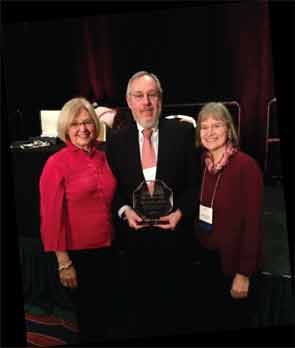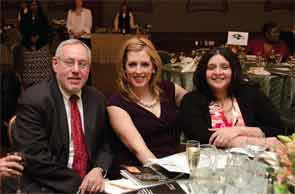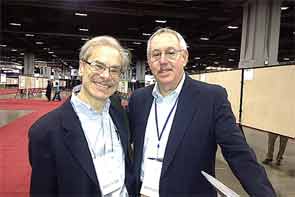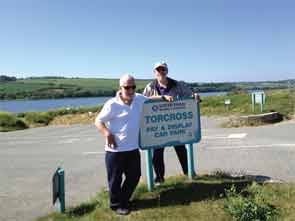
In 1977, during the second year of his two-year postdoctoral fellowship in the Connective Tissue Division, Department of Medicine at The Johns Hopkins Hospital, Baltimore, Marc C. Hochberg, MD, MPH, sought out his mentor, the late Lawrence E. Shulman, MD, PhD, to discuss his career goals. Dr. Shulman was about to depart from Johns Hopkins to become the first director of the (former) Arthritis and Rheumatism Branch of the National Institute of Arthritis, Diabetes, Digestive and Kidney Diseases (NIADDK), now the National Institute of Diabetes and Digestive and Kidney Diseases. During their long talk, recalls Dr. Hochberg, “Dr. Shulman pointed me in the direction of epidemiology and public health, identifying [it] as an underserved and understudied area in rheumatology.”
Taking Dr. Shulman’s advice to heart, Dr. Hochberg approached the head of the Connective Tissue Division, the late Mary Betty Stevens, MD, who had offered him a faculty position at Johns Hopkins upon completion of his fellowship. Dr. Stevens made it possible for Dr. Hochberg to spend half of his time during his first two years on faculty as a clinical instructor pursuing a graduate degree in public health. After receiving his master’s in public health, Dr. Hochberg was then promoted to assistant professor and remained at Johns Hopkins until 1991, adding an appointment in the School of Public Health (Epidemiology) in 1979.
Currently professor of medicine and epidemiology and public health at the University of Maryland School of Medicine, Baltimore, Dr. Hochberg had been Dr. Shulman’s last fellow before his departure for the NIADDK. And since he received that seminal career advice from his former mentor, Dr. Hochberg has arguably become one of the leading epidemiologists in rheumatology, says Lee S. Simon, MD, principal, SDG LLC of Cambridge, Mass., who has known Dr. Hochberg since he was a medical student.
“I’ve known Marc a long time, have watched his career and collaborated with him in the context of osteoarthritis work, as well as therapeutic outcomes. I think Marc is probably the most accomplished health services researcher in our rather narrow therapeutic field,” Dr. Simon commented.

Path to Rheumatology
By the time he was in high school, Hochberg was well on track to pursue a medical career. He grew up in New York City and attended the Bronx High School of Science. He says, “I was focused on going into medicine and pursuing a career in the biomedical sciences.” While an undergraduate at Franklin & Marshall College in Lancaster, Pa., he spent his senior year doing research in physical chemistry; this work resulted in his first peer-reviewed scientific publication.
Dr. Hochberg’s interest in rheumatology took shape during a nine-week elective clinical rotation as a fourth-year medical student at Johns Hopkins in 1972, when Dr. Stevens was head of the division. The first woman to chair that division, the charismatic Dr. Stevens was renowned for clinical research and treatment advances in lupus and other connective tissue diseases, and for encouraging many internists to choose rheumatology as a subspecialty. “It was largely due to the mentorship of Dr. Stevens and Dr. Shulman [that I became a rheumatologist],” said Dr. Hochberg.
At Johns Hopkins, a large patient population with systemic lupus, systemic sclerosis, rheumatoid arthritis (RA) and inflammatory muscle disease served to inform Dr. Hochberg’s concentration on the descriptive and analytic epidemiology in the connective tissue diseases. During his years as assistant professor at Hopkins, Dr. Hochberg often collaborated with Frank C. Arnett, MD, and began “exploring racial differences to try to understand the role of socioeconomic status to explain differences in development of disease as well as outcomes,” he says. This work continued in the 1980s, after the arrival of Michelle A. Petri, MD, MPH, who garnered a grant from the Hopkins General Clinical Research Center to establish the Hopkins Lupus Cohort. Dr. Hochberg worked with Dr. Petri and postdoctoral research fellows to investigate racial differences and clinical outcomes in patients with lupus.

A Shift of Research Focus
During the 1980s, Dr. Hochberg’s collaboration with postdoctoral fellow Ronenn Roubenoff, MD, MHS, blossomed into a cohort study of risk factors for gout, comparing white medical students at Hopkins with black students at Meharry Medical College. At this juncture in his career, said Dr. Hochberg, he began to shift his focus to gout and the more common arthropathies such as osteoarthritis (OA). The greater burden of disease with OA and its greater public health impact, coupled with the ability to look at environmental risk factors, were the primary reasons Dr. Hochberg was drawn to this field of study.
Another pull to OA came from Roy Altman, MD, professor emeritus, University of Miami, and professor of medicine, Division of Rheumatology and Immunology at the Ronald Reagan UCLA Medical Center, Los Angeles. At the time, Dr. Altman was involved in ACR’s development of classification criteria for OA. He recalls meeting Dr. Hochberg on a flight to the Southeast Regional Rheumatology meeting in 1981. “I think I got him interested in osteoarthritis at that time,” recalls Dr. Altman, who says that he recruited Dr. Hochberg for the OA classification criteria effort. Since that time, the two have continued to collaborate on numerous projects including recommendations for conducting clinical trials in OA for the Osteoarthritis Research Society International and management of OA. The latter recommendations were revised in 2012 under the auspices of the ACR.
“Dr. Altman was influential in my career as a mentor and now as my best friend,” says Dr. Hochberg. He and his wife were present for Dr. and Mrs. Altman’s 50th anniversary this past summer.
The admiration is clearly mutual. Reflecting on Dr. Hochberg’s qualities as a collaborative epidemiologist, Dr. Altman remarks, “Marc had an MPH before many other people did, and his work has contributed to epidemiology ballooning in importance in the field of osteoarthritis and osteoporosis. Not only is Marc very bright, but he’s able to take in a lot about the field and bring a ‘big tent’ in understanding to the discussion at hand.”

Collaborations Enrich & Inform
Dr. Simon shares Dr. Altman’s assessment of Dr. Hochberg: “He’s creative, thoughtful and innovative in approach, experienced in interpretation of clinical evidence and experienced in doing systematic reviews and in conceptualizing therapeutic responsiveness in the disease state.”
Those qualities came into play when a University of North Carolina master’s thesis candidate asked Dr. Hochberg to consult on her project. Joanne M. Jordan, MD, MPH, professor of medicine and chief of the Division of Rheumatology, Allergy and Immunology at the University of North Carolina (UNC) Chapel Hill School of Medicine, Chapel Hill, was a medical student at Johns Hopkins from 1977–81, when Dr. Hochberg was then on faculty. Ironically, the two did not have occasion to meet then.
Later, when her master’s paper at UNC became a funded grant, Dr. Hochberg became a consultant as the Johnston County Osteoarthritis Project (JoCo OA) was in the development stages. Even though the two had not met while she was at Johns Hopkins, Dr. Hochberg was familiar with a paper Dr. Jordan had written (with coauthors Carole Dorsche, MD, and Tom Zizic, MD) as a medical student during her time there. “That really impressed me,” she says, “that he took the time to find out about that paper and already knew a lot about me before he came to visit here.” What has been more impressive, though, is Dr. Hochberg’s penchant for inclusiveness on research projects. “Marc is a terrific thinker, speaks very clearly and is really interested in bringing people into the tent, particularly younger people. That is a contagious thing,” she says.
Since Dr. Hochberg’s initial consultations with Harold L. Cook, PhD, and John G. Fryer, PhD, on the JoCo OA protocol, the fruitful collaborations with Dr. Jordan, the current principal investigator of the JoCo OA Project, have continued. Generally seen as a pivotal study, the project has gone through phases I (1991–98) and II (1999–2005) and is currently in phase III, yielding important information regarding the existence of ethnic differences in OA, demonstrating higher rates of both radiographic and symptomatic OA prevalence among African Americans than formerly thought.
The commonalities across the numerous OA studies in which Dr. Hochberg has been involved have been, he says, “to try and identify modifiable risk factors for the development and structural progression of osteoarthritis.” Most cohorts, he points out, have data on hand and knee OA, while hip data were gathered in studies of osteoporotic fractures. Involvement with hip data took place when he and Sheri Tepper looked at the First National Health and Nutrition Examination Study (also known as NHANES-I) data, which included hip radiographs. With such work as the JoCo OA and the Baltimore Clinical Centers of the Study of Osteoporotic Fractures and Osteoarthritis Initiative, of which he’s been director for the past 15 and nine years, respectively, he and various collaborators have been able to examine the same joints in different cohorts to validate findings from one to the other.
Dr. Hochberg has also been involved since 1991 with the Osteoarthritis Research Society International (OARSI) and is presently collaborating with Drs. Altman, Jordan and Simon to revise the OARSI recommendations for conducting clinical trials in OA. Dr. Simon notes that in the collaborative environment, Dr. Hochberg “tends to include people in the thinking about his work rather than being a ‘solitarian’ analyst. He enjoys the perspective of working with groups of people, and he searches out other people’s opinions, which enriches—rather than minimizes—the work that he produces.”
‘Not only is Marc very bright, but he’s able to take in a lot about the field & bring a big tent in understanding to the discussion at hand.’
A Generous Mentor
Vicki L. Star, MD, FACR, is director of medical affairs for Merck & Co. and based in North Wales, Pa. She began her fellowship in rheumatology at the University of Maryland the year that Dr. Hochberg moved to that institution. Following that fellowship, she went on to a faculty position at George Washington University in Washington, D.C. Now deeply involved in clinical research on the pharmacology side, she still considers Dr. Hochberg a mentor: “He’s one of those rare people you can really open up to,” she says. “I still discuss ideas with him, and we carve out time to meet at every national meeting.”
While under Dr. Hochberg’s supervision at the University of Maryland, Dr. Star recalls that it was his enthusiasm for the public health and epidemiological aspects of rheumatology that sparked her interest in osteoporosis and other inflammatory disorders. Another quality she admires in Dr. Hochberg: “He is extremely generous as far as giving his time to people, making sure that people are engulfed in whatever the clinical research is and that they fully understand everything. He makes sure that all those involved in a project receive their accolades; he does not want to take full credit for anything. That’s uncommon for a researcher.”
The UK & Beyond
Besides his intense academic research and participation in several national organizations, Dr. Hochberg is active in international research initiatives. He traces this involvement back to a three-month faculty exchange in 1987, when he was a senior lecturer in the Department of Community Medicine at St. Thomas’s Hospitals in London. That led to a visit by Tim Spector, MB, MSc, MD, to Johns Hopkins as a postdoctoral fellow in 1988. For more than 25 years, Drs. Hochberg and Spector have been collaborators as well as friends. Dr. Spector now directs the Twin Research Unit in the UK and the Treat OA Consortium.
Dr. Hochberg was also the first senior ACR participant in the ACR/EULAR exchange program and enjoys active research and publishing collaborations with many other European rheumatologists (such as textbooks he co-edited with Alan Silman, MD, and Josef Smolen, MD) based on the relationships he established at that time. (To hear Dr. Hochberg’s reflections on the importance of collaborations with European researchers, visit http://www.the-rheumatologist.org.)
Dr. Hochberg reports that he finds great satisfaction in all domains of his current activities: epidemiological research focusing on OA and recovery from hip fracture, mentoring and training research fellows, and editing Rheumatology, 6th edition (to be published in June) and Seminars in Arthritis and Rheumatism. In the current funding environment, he sees challenges for academic institutions who wish to recruit and retain talented young faculty as physician-scientists. And in the face of healthcare reforms, such as the Affordable Care Act, it will become even more important, he believes, for rheumatologists to train their primary care colleagues to manage the more common rheumatic diseases—especially gout and OA—so that rheumatologists can concentrate on the patients with more difficult-to-control conditions, especially RA, other systemic inflammatory arthritidies and immune-mediated connective tissue diseases. With the depth of knowledge from epidemiologic research he’s pioneered, those practitioners will have the tools to carry out that charge.
Listen to excerpts of our interview with Marc C. Hochberg, MD, MPH.
Gretchen Henkel writes the Metrics in Rheumatology series.
Partial Bibliography
- Silman AJ, Hochberg MC. Epidemiology of Rheumatic Diseases. Oxford: Oxford University Press, 1993.
- Hochberg MC, Thomas J, Thomas DJ, et al. Racial differences in the incidence of gout: The role of hypertension. Arthritis Rheum. 1995;38:628–632.
- Hochberg MC, Altman RD, Brandt KD, et al. Guidelines for the medical management of osteoarthritis: I. Osteoarthritis of the hip. Arthritis Rheum. 1995;38:1535–1540.
- Hochberg MC, Altman RD, Brandt KD, et al. Guidelines for the medical management of osteoarthritis: II. Osteoarthritis of the knee. Arthritis Rheum. 1995;38:1541–1546.
- Berman BM, Lao L, Langenberg P, et al. Effectiveness of acupuncture as adjunctive therapy in osteoarthritis of the knee: A randomized controlled trial. Ann Intern Med. 2004;141:901–910.
- Moskowitz RW, Altman RD, Buckwalter JA, Goldberg VM, Hochberg MC, eds. Osteoarthritis: Medical and Surgical Management, 4th ed. Philadelphia: Lippincott Williams & Wilkins, 2007.
- Kraus VB, Jordan JM, Doherty M, et al. The Genetics of Generalized Osteoarthritis (GOGO) study: Study design and evaluation of osteoarthritis phenotypes. Osteoarthritis Cart. 2007;15:120–127.
- Hochberg MC, Silman AJ, Smolen J, et al, eds. Rheumatology, 5th edition. Philadelphia: Mosby (Elsevier), 2011.
